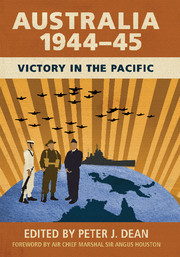Book contents
- Frontmatter
- Dedication
- Foreword
- Contents
- Maps and chart
- Figures and table
- Contributors
- Acknowledgements
- Abbreviations
- Military symbols on maps
- Introduction
- PART 1 STRATEGY
- PART 2 AUSTRALIA AT WAR
- PART 3 GREEN ARMOUR AND SPECIAL OPERATIONS
- PART 4 THE NAVAL AND AIR WAR
- 8 The RAN at War, 1944–45
- 9 ‘On the scrap heap of the Yanks’: The RAAF in the Southwest Pacific Area, 1944–45
- PART 5 THE NEW GUINEA CAMPAIGN
- PART 6 THE BORNEO CAMPAIGN
- Afterword: And Then Came Peace?
- Index
- References
8 - The RAN at War, 1944–45
from PART 4 - THE NAVAL AND AIR WAR
Published online by Cambridge University Press: 05 December 2015
- Frontmatter
- Dedication
- Foreword
- Contents
- Maps and chart
- Figures and table
- Contributors
- Acknowledgements
- Abbreviations
- Military symbols on maps
- Introduction
- PART 1 STRATEGY
- PART 2 AUSTRALIA AT WAR
- PART 3 GREEN ARMOUR AND SPECIAL OPERATIONS
- PART 4 THE NAVAL AND AIR WAR
- 8 The RAN at War, 1944–45
- 9 ‘On the scrap heap of the Yanks’: The RAAF in the Southwest Pacific Area, 1944–45
- PART 5 THE NEW GUINEA CAMPAIGN
- PART 6 THE BORNEO CAMPAIGN
- Afterword: And Then Came Peace?
- Index
- References
Summary
The dawn of 1944 revealed a Royal Australian Navy (RAN) still spread across several theatres of operations. While the last Australian ships had been withdrawn from the Mediterranean after the invasion of Sicily in 1943, a number of RAN officers and men remained serving with British and Canadian forces in the Atlantic and Mediterranean. Many were to be decorated for their gallantry in the series of amphibious landings, commencing at Anzio in January 1944, Normandy in June 1944, the South of France in August 1944 and in several smaller operations along the eastern coast of Italy as the allies pushed to reduce the defensive lines fiercely contested by the Germans. Several Australian naval personnel were, unfortunately, to lose their lives in these operations, while others fought on and under the sea to defeat the Germans. A few examples will illustrate the contribution made by the RAN in bringing the European war to its conclusion.
In a British midget submarine Lieutenant Hudspeth RANVR (RAN Volunteer Reserve) took reconnaissance parties onto Normandy D-Day beaches and then on D-Day endured the uncomfortable experience of acting as a beacon to guide the landing forces onto the beaches while under fire from both friend and foe. Lieutenant Thomas Foggitt, RANVR, a veteran of the Dieppe raid in 1943, won a Distinguished Service Cross for his gallantry in taking command of his landing craft when the commanding officer was hit and, although wounded himself, pressing on with the task of landing Royal Marines against ferocious German opposition at Walcheren Island near Antwerp in 1944. RANVR Lieutenant Commander Stanley Darling and two bars set an unequalled record by sinking three German submarines in the space of six months in the Atlantic in his Royal Navy frigate, while the men of the Render Mine Safe force continued to win awards for bravery both in the United Kingdom and, as the Allied forces advanced into Europe, in the ports which were liberated from the Germans. A George Cross was awarded to Lieutenant George Gosse RANVR for his gallantry and technical skill on the day following the German surrender, when he successfully defused one of the deadly German ‘Oyster’ pressure-activated mines in Bremen Harbour.
- Type
- Chapter
- Information
- Australia 1944–45Victory in the Pacific, pp. 171 - 189Publisher: Cambridge University PressPrint publication year: 2015



